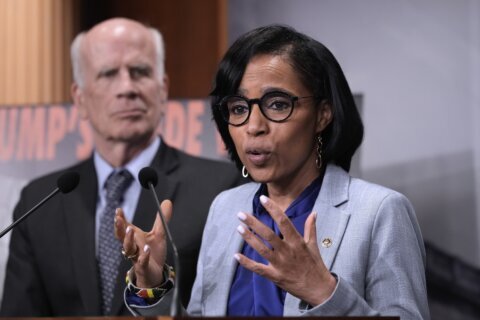This article was republished with permission from WTOP’s news partners at Maryland Matters. Sign up for Maryland Matters’ free email subscription today.
This content was republished with permission from WTOP’s news partners at Maryland Matters. Sign up for Maryland Matters’ free email subscription today.
In 2016, Robert Grossmann, 64, was fatally struck by a car along a busy stretch of Georgia Avenue, a short walk north from Metro’s Glenmont Station.
Five years later, his widow, Claire E. Weissmeyer Grossmann, 63, was killed two blocks away, attempting to cross the same busy thoroughfare.
Today, two pairs of shoes, painted white and nailed to a utility pole, memorialize the tragic twin deaths.
Safety advocates say the deaths, while agonizing, were not a surprise. Georgia Avenue (Maryland Route 97) has long been regarded as high-risk for pedestrians and cyclists. Two more pairs of white shoes are nailed to a utility pole a few hundred feet away.
Local officials and community activists say the loss of life underscores another phenomenon: the existence of known problem areas in the state’s transportation network about which not enough is done.
Earlier this month, the Maryland House of Delegates approved legislation aimed accelerating safety improvements along state highways. The bill is sponsored by Del. Lorig Charkoudian (D-Montgomery), a lawmaker who has conducted regular walking tours for three years with State Highway Administration officials at dangerous intersections in her district.
“It’s so important to ask them to come and look at the realities (rather than) at a map in a Zoom meeting,” she said. “It is absolutely different when you walk.”
Charkoudian’s bill would require the Maryland Department of Transportation to include design and safety improvements in “any construction or improvement project, or post-construction project, preservation or maintenance.”
If a new construction or improvement project is projected to take more than a year to complete, the agency would be required to “implement all possible incremental, near-term safety improvements immediately.”
In a letter to legislators, MDOT officials wrote that “many” of the bill’s requirements are already being implemented.
As originally drafted, the measure would have required $300 million be spent on safety improvements such as bike lanes, new crosswalks and special safety signals. After the agency warned that “funds would need to be shifted from previously programmed projects,” the measure was amended to include only those safety upgrades that qualify for federal funding.
Despite the change, Republicans opposed the legislation. Del. Christopher Adams (R-Middle Shore) said sponsors of the measure “are implying that the state makes bad decisions from a standpoint of safety.”
“At some point, we have to trust MDOT,” added Del. Jeff Ghrist (R-Upper Shore). “We just have to let them do their work.”
Del. David Fraser-Hidalgo (D-Montgomery) urged the House to reject Republican amendments to the bill. “There are multiple intersections where people have been killed or hurt over and over and over again,” he said. “What’s happening around the state is not acceptable.”
Charkoudian’s bill passed the House on a party line vote, 99-34.
Rachel Grossmann said the deaths of parents after being struck by vehicles along Georgia Avenue prompted her to become a safety advocate. She said attempting to engage state and local officials about the risks cyclists and pedestrians face every day has become part of her “healing.”
In 2019, SHA lowered the speed limit on the stretch of Georgia where Robert Grossmann died. In 2020, the agency added a traffic signal, a new crosswalk and pedestrian signal where Claire Grossmann was later hit.
Even so, more could be done, Rachel Grossman said.
“The changes are taking too long to implement,” she said. “It’s such an obvious problem.”
In her view, well-to-do neighborhoods are more successful in pressing for safety improvements than working-class areas. “Class and wealth play a role,” she said.
Prince George’s County Executive Angela D. Alsobrooks (D) submitted written testimony praising the bill’s insistence upon “industry standard context-driven design elements,” which she said will advance the county’s goal of eliminating roads deaths and injuries.
“Roadway fatalities are wholly preventable,” Salisbury Mayor Jacob Day told lawmakers. “Yet we must actively work to ensure that our roads remain safe for all modes of transportation, whether via a vehicle, on a bicycle, or by foot.”







